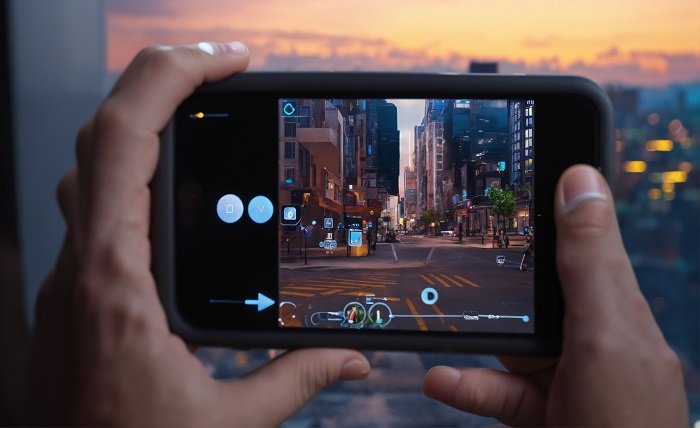He grew up thumbing plastic, memorising travel between A and B like a pianist drills scales. Now he watches labs demo finger flicks in mid‑air, pupils steering menus, even EEG headbands nudging cursors, and wonders: when the thumb finally retires, what takes its place?
In the same chat where he risks a quick tap in mines betting game, he sees players already modding inputs — gyro hacks, eye‑tracker overlays, voice macros. The urge is obvious: shave latency, free a hand, make intent feel instant. The controller is dissolving into the body, one sensor at a time.
From Plastic Shells to Phantom Interfaces
Buttons were honest: click equals action. Post‑button design deals in inference. Vision systems guess a grab, microphones parse half‑whispered verbs, neural nets translate micro eye jitters. He likes the magic and fears the guesswork. Missed reads tilt matches; false positives break flow. Future input has to feel like thought without acting before he thinks.
The Input Palette Expands (and Complicates)
- Hand and finger tracking that truly reads nuance — a pinch to tag, a twist to reload, a palm flare to parry — all without triggering “gorilla arm” fatigue.
- Let your gaze steer the pointer, with dwell timers that ignore stray looks; a blink acts as a modifier, not a booby‑trap.
- Voice parsed locally, with low‑latency wake words and slang models trained on dialects, not just broadcast English.
- Haptic wearables — from forearm sleeves to rings and even insole pads — return texture and heft so gestures don’t drift in a sensory void.
- Low‑friction brain interfaces (dry electrodes, optical sensors) picking up intention gradients rather than full command streams.
Design Rules Change With the Hardware
He realises UI has to stop assuming a static rectangle and two thumbs. If hands float, menus can arc around wrists. If eyes aim, HUDs must avoid clutter in the periphery. If thought spikes drive actions, games need consent layers to prevent stray impulses from ruining a run.
What Builders Need to Bake In Early
- Redundancy by design: every action mapped two or three ways so fatigue, noise or disability never locks a player out.
- Calibration as ritual, not chore — a 20‑second “warm up” at boot that feels like stretching before a match.
- Privacy prompts in plain language: where the gaze data goes, how long EEG snippets live, who can audit voice clips.
- Error forgiveness: soft confirmations, undo swipes, slow‑mo windows after high‑stakes gestures so intent can be cancelled.
- Social context toggles: public mode mutes voice macros, co‑op mode lowers gesture sensitivity so couch chaos doesn’t trigger spells.
Latency, Fatigue and the Physics of Flesh
Wireless stacks shorten, edge servers creep closer, but biology pushes back. Arms get tired faster than thumbs. Eyes dry out under stare‑to‑aim systems. Neural signals drift with mood and caffeine. He suspects hybrid controllers will linger — a slim pad with a few buttons, wrapped in sensors, letting muscle memory anchor the new tricks.
Ethics: When Input Becomes Intimate Data
A button press told a server nothing but timing. A gaze map or EEG trace whispers mood, distraction, maybe pathology. He wants guarantees: that “aim assist” doesn’t become “ad assist,” that biometric drift isn’t sold as engagement insight. Regulators lag; communities will likely draft the first good guidelines.
Culture Shifts With Control
Trash talk evolves when hands are busy mid‑air and voices trigger spells. Streamers will choreograph gestures like dance. Esports refs will review eye logs for aim hacks. Accessibility could finally flip — hands‑free paradigms might empower players locked out by traditional pads — if developers prioritise options over theatrics. He thinks of friends who game with chin sticks today and smiles at what eye‑plus‑voice could unlock.
Transitional Years Will Be Messy
Early motion controls taught everyone about novelty fatigue. He expects repeats: gesture gimmicks, eye trackers that misread glasses glare, mind bands that overpromise. The winners will be boring: systems that fail gracefully, explain clearly, and let players opt down to a button when the tech hiccups.
What He Hopes Survives
He doesn’t want tactility to vanish. Clicks, rumbles, resistance — these cues ground play. If buttons fade, haptics must evolve: richer textures, directional pressure, maybe thermal cues. He also wants clarity: a way to see, at a glance, what the system thinks he meant. Ghost inputs kill trust faster than any frame drop.
The End State (If There Is One)
Maybe there’s no single “controller of the future,” just a wardrobe. A ring for transit commutes, a glove for VR raids, a headband for strategy nights, a trusty micro‑pad for hotel rooms. Software will weave them, asking at launch, “How do you want to play right now?” and meaning it.
Closing Lap
Buttons won’t die; they’ll be demoted to safety nets. Gestures, gaze and thought will climb the ladder — carefully, unevenly, sometimes annoyingly — until the most natural input is the one you forgot you were giving. He’ll miss the old click, maybe keep a retro pad on a shelf, but he’s ready to flick his wrist, glance left, think “jump” — and feel the game move with him, not after him.
You May Also Like :
